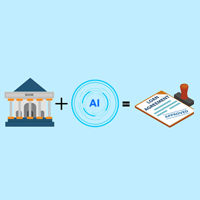
What You Should Look For When Analysing A Loan Applicant’s Bank Statements?
In the realm of lending, especially within microfinance institutions (MFIs), the analysis of a loan applicant's bank statements is a critical step in assessing creditworthiness. Bank statements offer a transparent view into an applicant's financial behavior, income stability, and spending habits. For lenders aiming to minimize risk and ensure responsible lending, understanding what to look for in these statements is paramount.
This comprehensive guide delves into the key aspects lenders should scrutinize when evaluating bank statements, highlighting how Microfinance banking software can streamline and enhance this crucial part of the loan approval process. We'll also explore how digital tools can eliminate manual errors, speed up decision-making, and reduce fraud — all while helping institutions serve the right clients.
Why Analyzing Bank Statements Matters in Lending
Bank statements provide a real-time snapshot of a borrower's financial health. Unlike credit scores or application forms, which may be outdated or manipulated, bank records show what actually happens with the borrower’s money. For lenders, especially those serving underserved or rural populations, this analysis can make or break the quality of the loan portfolio.
For microfinance institutions, where even a single non-performing loan can impact profitability, the ability to read between the lines of a bank statement is a competitive edge. That’s why many lenders today are turning to Microfinance banking software for automated and insightful analysis.
Read: Ways Lenders Can Validate a Company’s Eligibility for Business Loans
Key Things to Look For When Analyzing Bank Statements
1. Income Regularity and Stability
The first and most obvious checkpoint is verifying that the applicant has a regular income stream. This includes:
- Salaries or business revenue deposits
- Rental income
- Government subsidies (if any)
Look at the timing and amount of deposits. Irregular or unpredictable income patterns can signal a higher risk of loan default. Stable earnings over at least six months are usually a positive indicator.
✅ Pro tip: Microfinance banking software can automate the income recognition process by detecting consistent credit entries and flagging irregularities.
2. High Number of Bounced Transactions or Charges
Frequent bounced cheques, NSF (non-sufficient funds) charges, or overdrafts signal poor money management and liquidity issues. These are red flags that the applicant may not be financially disciplined.
Some applicants might clear dues just before applying for a loan — a careful timeline review can reveal these trends. A high number of charges over a 3–6 month period typically indicates higher credit risk.
3. Excessive Cash Withdrawals
Excessive cash withdrawals, especially in large amounts, may suggest:
- Income that’s not declared or taxed
- Involvement in informal lending or risky financial behavior
- Lack of digital financial discipline
Lenders should investigate the purpose of such withdrawals, especially if they are frequent and the usage is unclear.
Also read: Why Advanced Microfinance Software is Critical for Compliance
4. Unusual or One-Time Large Credits
Sudden, large deposits just before applying for a loan may be an attempt to inflate income and appear creditworthy. Always verify whether the source of such funds is legitimate and recurring or just a one-off setup.
Some fraudsters temporarily transfer money into an account to make the applicant look financially sound. A good practice is to review the past six to twelve months of bank data to verify consistency.
5. Recurring Monthly Obligations
Analyzing regular outgoing payments gives a clear picture of existing liabilities. Look for:
- EMI payments (other loans, car, education, etc.)
- Credit card payments
- Rent or utility bills
This helps you calculate the Debt-to-Income Ratio (DTI), one of the most important indicators of repayment ability.
📌 A healthy DTI is generally considered to be below 40%. Microfinance banking software can calculate DTI automatically based on transaction patterns.
6. Savings and Account Balance Trends
Lenders should look for a healthy end-of-month balance across multiple months. If an applicant regularly hits zero or overdraft, it’s a sign of living paycheck to paycheck.
Conversely, a steady or growing savings pattern implies financial discipline and a buffer against repayment stress.
7. Spending Habits and Lifestyle Choices
Yes, bank statements can reveal lifestyle trends. Frequent spending on luxuries, entertainment, or gambling apps might indicate poor prioritization of finances. While it may not disqualify the applicant, it's something worth considering, especially when evaluating borderline cases.
Using AI-powered transaction categorization, Microfinance banking software can assign spending types and generate a behavioral risk profile.
Also read our article on: How to Secure Your Lending Platform Against Cyber Threats
How Microfinance Banking Software Enhances Bank Statement Analysis
Gone are the days when loan officers had to manually sift through pages of bank statements. Modern Microfinance banking software automates this task and provides deep insights within minutes. Here's how:
✅ 1. Automated Income and Expense Categorization
Software tools can scan through thousands of transactions to determine consistent income streams and classify expenses under predefined categories.
✅ 2. Behavioral Risk Scoring
Machine learning algorithms analyze transaction frequency, anomalies, and financial behavior to score borrowers beyond traditional credit scoring models.
✅ 3. Fraud Detection
From fake documents to manipulated bank statements, software systems can identify discrepancies and flag applications for further review.
✅ 4. Real-Time Verification
The best systems integrate with banks and financial aggregators using APIs to fetch real-time statements directly, ensuring no tampering.
✅ 5. Digital Audit Trails
Every analysis and decision point is logged, creating transparency for regulatory and internal compliance checks.
Common Mistakes Lenders Should Avoid
- Relying solely on credit scores: Many first-time borrowers may not have a formal credit history, but their bank transactions can still tell a story.
- Ignoring micro-transactions: Small-value entries might signal ongoing debt cycles or hidden loans.
- Reviewing statements too narrowly: A 1-month statement doesn’t reflect seasonal income changes or long-term spending habits.
- Skipping document validation: Always verify authenticity before analyzing the content.
Also check: Game-Changing Strategy for Modern Financial Institutions
Real-World Example: When Bank Statement Analysis Saves the Day
A microfinance lender received an application from a small business owner requesting a ₹2 lakh working capital loan. On paper, everything seemed normal. But the bank statement analysis revealed:
- A recent large deposit 3 days before the loan application
- Repeated bounced EMIs from another NBFC
- Declining end-of-month balances for 4 consecutive months
Thanks to their Microfinance banking software, the lender flagged the application for review. A call confirmed that the deposit was a loan from a friend to make the account look healthy.
Without the right software, this red flag might have been missed, potentially resulting in a default.
Final Checklist for Bank Statement Analysis
Before approving any loan, ensure you’ve reviewed:
✅ Income regularity and source
✅ Outgoing liabilities and EMIs
✅ Frequency of overdrafts or bounced cheques
✅ Savings trends and end-of-month balances
✅ Spending behavior and lifestyle indicators
✅ Sudden large transactions or inconsistencies
✅ Authenticity and completeness of documents
Use these indicators along with your institution’s lending criteria for a balanced decision.
Conclusion: Smarter Lending Starts with Smarter Analysis
Bank statement analysis isn’t just about numbers — it’s about understanding borrower behavior, risk exposure, and financial responsibility. By knowing what to look for and using the right tools, lenders can improve loan quality, reduce defaults, and build trust with clients.
Modern challenges require modern solutions. That’s where Gtech Web Solutions PVT. LTD. comes in. As a leading provider of microfinance software and business solutions, they offer powerful Microfinance banking software that enables seamless bank statement analysis, fraud detection, and end-to-end digital loan processing.
Their tools are trusted by growing NBFCs and microfinance institutions across India, helping them lend with confidence, speed, and security.


